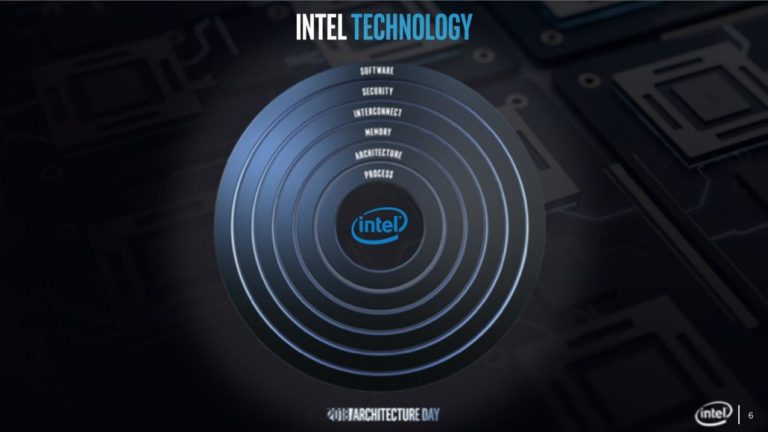
At Intel’s recent Architecture Day, Raja Koduri, Intel’s senior vice president of Core and Visual Computing, outlined a strategic shift for the company’s design and engineering model. This shift combines a series of foundational building blocks that leverage a world-class portfolio of technologies and intellectual property (IP) within the company. This approach is designed to allow Intel to drive an accelerated pace of innovation and leadership, and will be anchored across six strategic pillars:

 Related Intel Sunny Cove CPU Architecture and Next Generation Roadmap Revealed
Related Intel Sunny Cove CPU Architecture and Next Generation Roadmap Revealed
- Process – Access to leadership process technology remains essential to building leadership products. Advanced packaging solutions will enable Intel to continue exponential scaling in computing density by extending transistor density to the third dimension.
- Architecture – The future is a diverse mix of scalar, vector, matrix and spatial architectures deployed in CPU, GPU, accelerator and FPGA sockets, enabled by a scalable software stack, integrated into systems by advanced packaging technology.
- Memory – High-capacity, high-speed storage is crucial for next-generation computing workloads. Intel is uniquely positioned to combine in-package memory and Intel Optane technology to fill gaps in the memory hierarchy to provide bandwidth closer to the silicon die.
- Interconnect – Communication scales from wireless connections for 5G infrastructure to silicon-level package and die interconnects. Only by offering a complete range of leading interconnect products enables the heterogeneous computing landscape at scale.
- Security – With the emergence of new threats, Intel has all the components to build a “better together” security strategy. Intel is uniquely positioned to deliver security technologies that help improve the end-to-end and to make security advancements a key differentiator.
- Software – For every order of magnitude performance potential of a new hardware architecture there are two orders of magnitude performance enabled by software. A common set of tools that can address Intel silicon for developers is critical to exponential scaling.
Question and answer session with Raja Koduri
1) Why do you believe that in this new era of computing Intel should anchor its product and technology strategy around these six pillars?
The landscape for computing has evolved dramatically over the past decade. We operate in a world where we generate data at a faster rate than our ability to analyze, understand and help secure it. We see immense demand for computing architectures that evolve rapidly and scale exponentially. We have a bold engineering vision over the next five years to deliver 10 petaflops of compute and 10 petabytes of data within 10 milliseconds to every person in the world. We believe these six technology pillars are the key enablers for us to drive the needed product innovation to achieve this.
2) How do the IP and resources in the six pillars best position Intel to win and deliver differentiated products from your competitors?
 Related Intel’s 10nm Gen 11 Graphics Detailed – 1 TFLOPs of Power and Landing in 2019
Related Intel’s 10nm Gen 11 Graphics Detailed – 1 TFLOPs of Power and Landing in 2019
When I joined Intel, I was amazed at the sheer volume and breadth of IP available to us. In nearly three decades in the industry, I’ve never seen anything like it. The scale of these resources gives us a differentiated set of technologies in each of these pillars to apply as we drive wave after wave of innovation for client, edge and cloud computing environments. I believe we are uniquely positioned to deliver leadership across all six of these pillars which provides a foundation for sustained innovation nobody else can offer.
3) Why did the innovation model have to change?
The world has changed and so has our business; we’ve moved to target an addressable market north of $300B*. The rising demand for computing provides us with a chance to change, mold and expand Intel in an unprecedented manner. We have a responsibility not only to ourselves, but also to our customers who trust us with their businesses, critical data and computing needs, to reinvent our products and strategy for developing technologies for the next decade and beyond.
4) How is Intel applying the model today and in the future?
We’re applying the model today across our engineering organization as we bring innovative new product and technology initiatives to the world next year and into the future. Whether it’s the advanced packaging innovation through “Foveros” logic stacking or the “One API” approach to software developers, we’re taking steps to drive sustainable new waves of innovation.
5) How does the shifting landscape in computing workloads impact how Intel will build its next-generation products?
The workloads associated with this computing landscape are changing. No longer do consumers or enterprise customers have simple applications that can be addressed with straightforward scalar architectures alone. Instead we see programs that are solving problems faster by integrating additional architectures from graphics processors to artificial intelligence accelerators to image processors and even adaptable designs like FPGAs powered by new memory technologies. We will combine computing and architecture innovations through high-speed interconnects with new models for software development that simplify APIs for developers and allow more performance and efficiency to be unlocked from Intel computing architectures.
6) How do Intel’s investments in the six pillars drive Moore’s Law-like leaps forward in user experience?
In the previous generations, the answer has been that transistor density and Moore’s Law will play the lead role to solve computing problems. But as the process node transitions have slowed from the pace of the previous decades, it is the essence of Moore’s Law that continues to provide new technologies and capabilities to meet the demands of modern computing. The message of Moore’s Law is about more than transistors alone, with the combination of transistors, architectural research, connectivity advancements, faster memory systems, and software working together to drive it forward.





































































